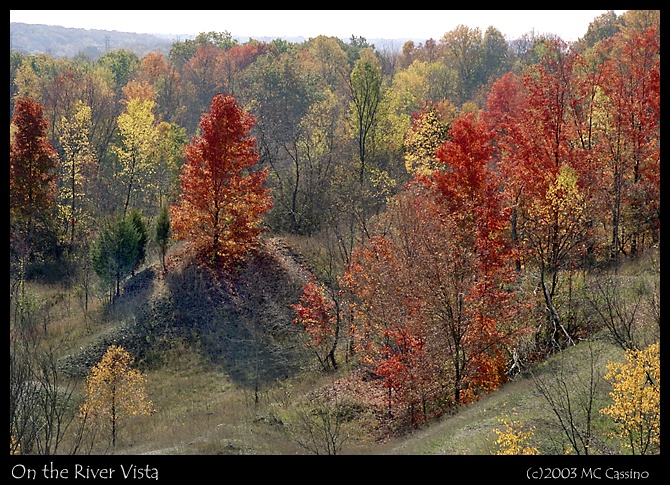Along the River Vista I
Autumn is an in-between time. You never know what to expect – anything is possible, and everything is unreliable. So when photographing the natural world at this time of year, you have to be prepared for anything. And that means carrying around a lot of gear.
Yesterday I spent the day at the Kalamazoo Nature Center. I hadn’t been there for more of the summer, but with the Allegan Forest full of hunters and the fall colors well on their way, the rolling hills of the Nature Center seemed to be a good choice.
I spend the day hiking the River Vista trail. This is a meandering path that works its way along through an area that was once a gravel pit. The trail runs along a ridge line, possibly an old railroad track bed. The are several deep depressions – areas once excavated for gravel. One side of the field is bounded by an active railroad track, with the Kalamazoo River beyond that. The other side is bounded by some of the highest hills in the area.
I had hopes of shooting dragonflies – in the spring and summer the area is pretty productive for dragon and damsel flies. There are two small retention ponds at the base of the valley the are usually very active with dragonflies.
I also had hopes of shooting fall colors. This area has been productive in the past, and I was surprised to see how far along some of the trees were this early in the year.
To cover all my bases, I took along the Lowepro mini-trekker, loaded with the Pentax Mz-S, the standard collection of lenses, several rolls of 35mm B&W film, an X’s Drive II, Compact flash cards, and a few water bottles and a Holga to boot (its amazing how much stuff you can cram into one of those bags!) I decided to carry the *ist-D insect shooting setup – camera, lens, flash, and monopod – outside of any bag, on the theory of having it handy for insect encounters.
To cover possible landscape shots, I took another bag with the Pentax 6x7, three lenses (55, 105, and 170 mm) filters, film, and light meter. Along with that I brought the heavy duty tripod, to support the 6x7 camera.
Altogether, this added up to close to 50 lbs of gear, which made hiking up and down the hillsides a little slow. As it turned out, the insects were a complete bust – I wound up taking only a handful of shots, and only one is even passable.
Landscape work was more promising. I shot three rolls of 120 B&W, and two rolls of 220 Fuji NPS. The fall colors and clear blue sky looked great – we’ll how the images come out once the film is developed. I also shot a couple of rolls of 35mm B&W, mostly detailed studies of the cracks and effervescence in the ruins of an old coal hopper.
Logistically, it was a bad day for film. Twice I wound up accidentally tearing off the leader of a roll of film while loading it into the 6 x 7 camera. That’s a new thing – and it was a real pain. It for certain ruined the first few frames of each roll, and may well have affected the entire roll. In addition, the camera counter got out of synch when I ripped the leader on a roll of 220, and I wound up merrily shooting away for a while before I realized that the roll was long over. To top it off, the first roll of 35mm Delta 100 I loaded up jammed after just a few frames – resulting in having to pull it out and toss the roll. Fortunately I had just gotten started with it, and was able to re-shoot what I had started.
Well, we’ll see what comes of all this. No new photos with this post – the shot of the River Vista Trail is from a couple of autumns ago. The NPS is waiting for a trip to the lab next week, and the B&W is awaiting development. More next week when the results are in.
